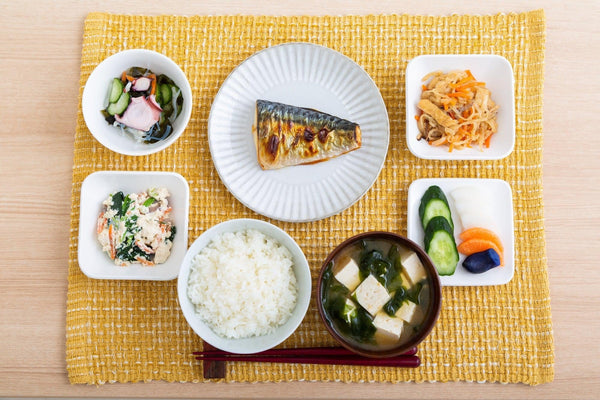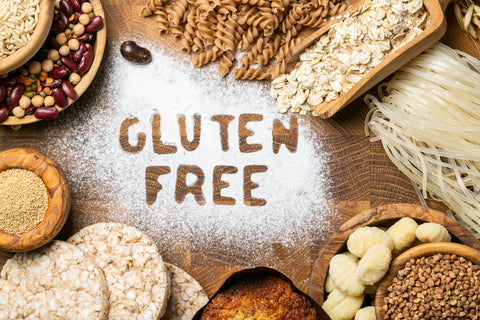
Jump to:
At first glance, one might think of Japan as a country in which it would be fairly easy to exist if you are gluten-intolerant or are choosing to eat gluten-free for health reasons.
Historically, it has been rice, rather than wheat that is the predominant starchy food grown and used in cooking. However, as we shall explore in this blog post, avoiding gluten is not as simple as merely staying away from your local bakery, as gluten lurks in unexpected places in Japanese food.
In this article, we shall look at the definition and origin of gluten-free diets, gluten-free standards used in Japan, and food in Japan that is naturally gluten-free, as well as foods to avoid. We shall also look at what gluten-free options there are from convenience stores, some restaurants offering gluten-free options, and also include some links to gluten-free snacks and recipes.
What Does It Mean To Be Gluten-Free?
Gluten-free, as the name suggests, refers to foods not containing more than a certain amount of gluten, and generally refers to a diet in which all foods containing gluten are excluded. Gluten is a type of protein found in wheat, barley, rye, etc. In the case of wheat, it is made up of two intertwined proteins, glutenin and gliadin. When wheat flour is kneaded with water, the two types of proteins are bound together to form a viscoelastic mesh structure, and this property is used to make bread, cakes, pizza, pasta, confectionery, and the like.
Gluten-free originated as a diet for people suffering from celiac disease. Celiac disease is an inherited autoimmune disease that causes an abnormal reaction to gluten, causing the autoimmune system to attack the tissues of the small intestine, resulting in inflammation and the destruction of small intestinal cells. This results in a variety of symptoms, including decreased absorption of nutrients, abdominal pain, diarrhea, and fatigue.
Attention was drawn to the condition when Novak Djokovic, a world-renowned tennis player, published a book claiming that his body improved after he changed to a gluten-free diet after he received a diagnosis, through blood tests and other means, suggesting that wheat and dairy products were not compatible with his constitution. In addition to celiacs, the diet has been adopted by athletes who believe that eating gluten-free is a way to unlock higher performance levels.
International Gluten-Free Standards Used In Japan

So, how should you choose what to eat if you are trying to follow a gluten-free diet in Japan? In addition to checking the ingredients on foods, a good rule of thumb when looking for foods that contain no more than a certain amount of gluten is the "Gluten-Free Certification Mark". The GFCO (Gluten-Free Certification Organization) is a certification body for gluten-free foods developed by the American Gluten Intolerant Association. GFCO certification operates under strict criteria and guarantees the gluten-free safety of certified foods to consumers with celiac disease and gluten intolerance* worldwide. The certification mark is therefore trusted by consumers internationally.
Although gluten-free labeling varies from country to country, the standard for gluten-free labeling common to all countries is less than or equal to 20 mg of gluten per kilogram of wheat, or less than or equal to 20 ppm (0.002%) of gluten. GFCO's gluten-free labeling standards set a standard of less than 10ppm of gluten content, which is stricter than other international standards.
What Food In Japan Is Naturally Gluten-Free?

Many of the main ingredients that make up Japanese food are naturally free of gluten. These include rice, in its standard form as well as rice products such as:
- Mochi rice cakes and Onigiri rice balls
- Soybean products such as Miso, Tofu, and Natto
- Eggs
- Fish including Sushi and Sashimi
- Processed Fish Products such as narutomaki
- Fruit and Vegetables
- Some types of Noodles
Hidden Dangers – Sauces, Condiments and Coatings

However, before you get stuck into the above, it is important to realize that there are some important caveats when labeling the above foods gluten-free. The biggest problem is that the above foods are usually not served in a vacuum and come with sauces and condiments.
The big one is soy sauce. The three main types of soy sauce are Koikuchi (Dark), Usukuchi (Light), and Tamari soy sauce. Of these, Tamari soy sauce only uses soybeans and salt as its ingredients (most of the time), but this is generally used only (and only sometimes) as a dipping sauce for Sushi, and the far more prevalent two other varieties, which contain wheat, will be out of bounds for those staying away from gluten. (If you are preparing food yourself, though, you should definitely check out this article about gluten-free soy sauce.)
This includes not only soy sauce itself, but other sauces such as Ponzu sauce that contain soy sauce. Soy sauce is a very common ingredient in many sauces used in restaurants and off-the-shelf sauces in supermarkets, so it is necessary to be extra careful when eating anything with a sauce. Certain dishes, such as Yakitori skewered meat, come in two varieties, cooked with salt or with sauce. The salt option is definitely safer.
So, if you can be sure that you are using Tamari soy sauce, or you go without soy sauce, altogether, does that give you free rein to enjoy Sushi? Not quite, as small amounts of wheat are used in various condiments, including vinegar, and you need to make sure the Sushi uses 100% rice vinegar.
You also need to be careful with things covered in batter (such as Tempura) or breadcrumbs (like Tonkatsu), as these will often contain wheat products. You will need to innovate if you wish to enjoy these dishes. See our recipes here for gluten-free Tempura and how to make gluten-free Karaage fried chicken. If you want to make your food yourself using breadcrumbs, check out this gluten-free Panko.
Wheat-Based Japanese Food

There is also a range of Japanese foods that are a complete non-starter if you are abstaining from gluten due to the fact that they are heavily wheat-based. These include Okonomiyaki, which uses flour, wheat-based noodles such as Udon, Ramen, and Somen, as well as popular Chinese-style dishes extremely popular in Japan, such as Gyoza dumplings that use wheat in their skin wrappers, and curry roux. Unless you can find versions of these dishes made with rice flour, etc. it is probably best to stay right away.
As noted above, many varieties of Japanese noodles contain gluten, but what of Soba noodles? Well, although Soba flour itself does not contain gluten, wheat flour is often used as a binding agent, so is best to ask in advance. Juwari (meaning pure) Soba, on the other hand, is made using only water and buckwheat flour, without additives, so these will be safe to eat.
If you have a craving for noodles other than Juwari Soba, we would recommend these gluten-free Udon and Somen noodles as well.
Gluten-Free Snacks In Convenience Stores

If you are out and about in Japan and cannot find a restaurant that you know serves gluten-free food, the convenience store is a good place to go get something to tide you over until you can enjoy a substantial meal. In Japan, convenience stores are plentiful and open around the clock.
Some of the major convenience store chains like Seven-Eleven, Lawson, and Family Mart have their own brands of gluten-free snacks (look for “グルテンフリー“ on the packaging), and you can also find the following food that is naturally gluten-free: Meiji yogurt, green salad, fresh fruit salad, boiled eggs, Onigiri rice balls (though not if they include soy sauce), luncheon meat, cheese, SOYJOY bars, and Meiji chocolate bars.
It is worth learning the kanji for wheat (小麦) and the slightly more difficult soy sauce (醤油), so you can check the ingredients. Note that even if wheat or soy sauce is not listed as one of the ingredients, they may have been made in the same factory as wheat products. This will be in a different section on the label, so you should examine it carefully.
Gluten-Free Restaurants And Eateries

Convenience stores are handy, but you may want to enjoy dining out every now and then, and without having to quiz the chef. Fear not! We shall introduce a few places you can go to below where you can be sure of being served gluten-free food.
You can eat with complete peace of mind at this restaurant, in the heart of Roppongi in Tokyo, which offers a completely gluten-free menu, including gluten-free versions of favorites such as Gyoza, Okonomiyaki, Tempura, Yakisoba, and Ramen.
Pizzakaya
If you have a craving for pizza, Pizzakaya, also in Roppongi, offers pizzas with gluten-free crusts. They also offer standard pizzas, but the preparation facilities are kept completely separate to avoid contamination.
Comecono Gluten-Free Laboratory & Cafe
If you are in the Kansai area, this dedicated gluten-free café offers a wide range of delicious sandwiches, pastries, and desserts, as well as lunch sets including pasta dishes.
Sari Sari Store
If you have the hankering for something sweet, the Sari Sari Store, in Naniwa Ward in Osaka, offers coconut-flavored ice cream with gluten-free cones.
Going Gluten-Free in Japan
As we have learned in this article, going gluten-free in Japan has its challenges, but it is certainly not impossible. In addition to learning simple Kanji that can help you navigate the ingredient list on food labeling, you can acquaint yourself with Japanese food that is naturally gluten-free, cook for yourself using gluten-free versions of other foods, and treat yourself to eating out at the growing number of gluten-free restaurants.
Have you found any other good gluten-free food to eat in Japan or been to any particularly good gluten-free restaurants? Let us know in the comments.


0 comments